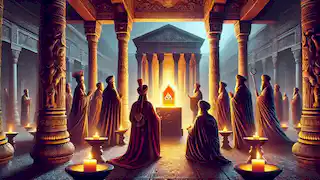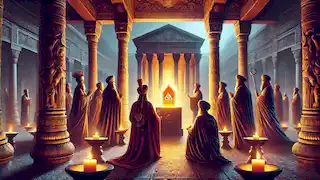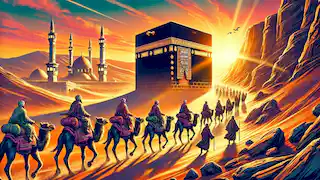The story of the Black Stone of the Kaaba has fascinated scholars, historians, and religious devotees for centuries. Located in the sacred sanctuary of the Kaaba in Mecca, this mysterious stone holds a revered place in Islamic tradition, symbolizing divine connection, forgiveness, and pilgrimage. Its origins, however, have been the subject of much debate and legend. In particular, one intriguing narrative suggests that the stone’s journey may have passed through Iran, adding an additional layer to its already rich history.
This story explores that journey, weaving together historical accounts, myths, and cultural ties between the Arabian Peninsula and ancient Iran. We will delve into the role the Black Stone played in the cultural and religious exchanges of early civilizations, how it may have been transported to Mecca, and what significance this connection has for Muslims and historians today. The Black Stone, or "Al-Hajar al-Aswad" as it is known in Arabic, has long been considered a sacred object within the Islamic faith. According to Islamic tradition, the stone dates back to the time of Adam and Eve, who were the first humans on Earth. Some say it was brought from Heaven, a gift from God to guide humanity. This belief in its divine origin only heightened its status over time, making it a focal point for pilgrimage. However, before it became synonymous with the Kaaba, the stone had a more complex history, one that potentially links it to the ancient lands of Persia. Scholars suggest that there are elements of Zoroastrianism, an ancient religion founded in Iran, that bear similarities to the way the Black Stone is revered in Islam. Some legends even suggest that the stone was once held in a Persian temple before being transported south to the Arabian Peninsula. The ancient region of Elam, part of what is now southwestern Iran, had long been a crossroads of cultures. This region was known for its sacred objects and its practice of venerating objects with religious significance, much like the Black Stone would come to be revered in Mecca. Could it be that the Black Stone was originally from Elam, carried down through trade routes to its final resting place? As we explore this possibility, we must first look at the significance of such stones in ancient cultures. In Zoroastrianism, fire was central to worship, but sacred stones also held importance, often symbolizing a connection to the divine. These stones were treated with respect and sometimes associated with purification rituals. One such stone, described in Persian mythology, was known to have fallen from the sky—an eerily similar description to the origin of the Black Stone. Though there is no direct evidence to confirm that the Black Stone came from Iran, historical accounts suggest that there was considerable cultural exchange between Persia and the Arabian Peninsula during the early centuries. Persian influence on Arabian culture is well-documented, particularly during the Sassanid Empire, which ruled much of the region from 224 to 651 CE. During this time, trade routes crisscrossed the Arabian Desert, connecting Persia with regions as far away as India, Egypt, and Byzantium. Caravans carrying goods such as silk, spices, and precious stones passed through cities like Mecca, which was already becoming an important hub for trade. The possibility that a sacred object like the Black Stone could have been transported from Persia along these routes is not as far-fetched as it might first seem. In fact, ancient Persian texts allude to "stones of the gods" that were revered in various parts of the empire. One such text mentions a stone of divine origin that was said to glow with an otherworldly light, guiding travelers through the desert. This tale bears a striking resemblance to Islamic traditions about the Black Stone, which is said to have once glowed so brightly that it could be seen from great distances. The Persian city of Ctesiphon, located near modern-day Baghdad, was a center of learning and religion. It is possible that the Black Stone passed through Ctesiphon on its way to Mecca, carried by traders or religious devotees seeking to establish a place of worship. There are even some accounts that suggest the Black Stone may have been part of a larger set of relics, all of which were dispersed across the ancient world. How exactly did the Black Stone end up in Mecca? The answer lies in the complex network of trade routes that connected the ancient world. During the early centuries of the Common Era, Mecca was already gaining importance as a center for trade and pilgrimage. The city was home to the Kaaba, a cuboid structure that housed various idols and religious artifacts. At this time, the Kaaba was not exclusively a Muslim site, but a sanctuary for people of different faiths. According to one legend, the Black Stone was brought to Mecca by a group of travelers who had acquired it during their journey through Persia. These travelers, sensing the stone's sacred power, sought to place it in a location where it could be venerated by all. The Kaaba, already an important religious site, seemed the perfect place. Once the Black Stone was installed in the Kaaba, its significance grew exponentially. Local tribes began to treat it as a divine object, and pilgrims from across the Arabian Peninsula came to see it. Over time, the Black Stone became synonymous with the Kaaba itself, and when the Prophet Muhammad established Islam as the dominant faith in the region, the stone took on an even more profound religious significance. By the time of the Prophet Muhammad, the Kaaba had become the spiritual heart of Arabia. The Black Stone, now embedded in the eastern corner of the structure, was central to the rituals associated with the Hajj pilgrimage. According to Islamic tradition, the stone was originally white but had turned black over the centuries due to the sins of those who touched it. The Kaaba itself was rebuilt several times throughout history, and the Black Stone endured through each reconstruction. One of the most significant events in the stone's history occurred in 930 CE, when it was stolen by a sect known as the Qarmatians. This group, based in modern-day Bahrain, raided Mecca and took the Black Stone back to their stronghold. It was not returned to the Kaaba for over two decades, and when it was, it had been broken into several pieces. Despite this, the Black Stone remains a symbol of unity and forgiveness in the Islamic faith. Pilgrims who visit the Kaaba during the Hajj attempt to touch or kiss the stone, believing that doing so absolves them of their sins. The act of circumambulating the Kaaba, known as Tawaf, is one of the central rituals of the pilgrimage, and the Black Stone plays a key role in this act of devotion. Even today, the origins and nature of the Black Stone remain shrouded in mystery. Some have suggested that it is a meteorite, given its otherworldly appearance and the legends surrounding its fall from the sky. Others believe it may be a type of volcanic rock, formed during ancient eruptions in the region. What is certain is that the Black Stone has captured the imagination of generations of believers, scholars, and explorers. Its connection to both the spiritual and physical world makes it a unique artifact, one that continues to inspire devotion and curiosity. {{{_04}}} Some scientists have attempted to study the composition of the Black Stone, though access to it is limited due to its sacred status. Initial findings suggest that it is not composed of any known earthly material, further adding to the air of mystery that surrounds it. The Black Stone of the Kaaba stands as one of the most revered and enigmatic objects in the world. Its journey, potentially linked to the ancient lands of Iran, adds a fascinating dimension to its already rich history. While the exact origins of the stone may never be known, its significance within the Islamic faith is unquestionable. For Muslims, the Black Stone represents a tangible connection to the divine. It is a symbol of God's mercy and a reminder of the unity of the faithful. For historians and scholars, it serves as a fascinating link between the ancient cultures of Persia and Arabia, highlighting the ways in which religious and cultural exchanges have shaped the world as we know it. The story of the Black Stone is one of faith, mystery, and history—a story that continues to inspire and captivate those who seek to understand the deeper meanings behind this sacred relic.Origins of the Sacred Stone
The Persian Connection

The Journey to Mecca

The Kaaba and Islamic Tradition

The Mysteries of the Black Stone
Conclusion: A Symbol of Faith and Unity


















